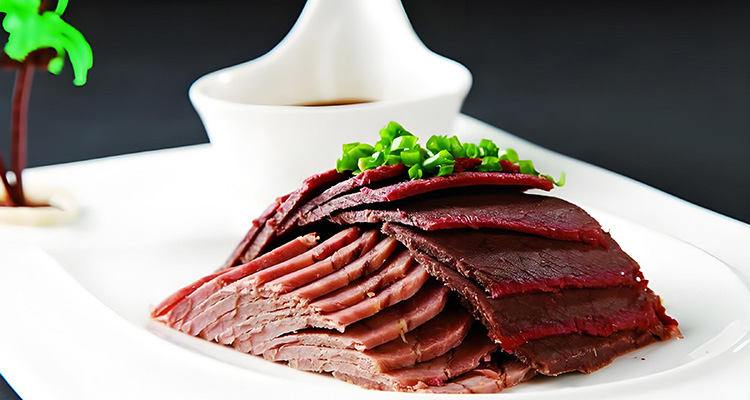Shangdang Cured Donkey Meat: Shanxi’s Flavorful Tradition
1. A Timeless Aroma: Discovering Shangdang Cured Donkey Meat
Strolling the old streets of Changzhi in Shanxi, you may suddenly be drawn by a rich, singular meat aroma. That scent comes from a centuries-old local specialty—Shangdang cured donkey meat. More than a dish, it is edible history, carrying the culture and craftsmanship of the Shangdang region. Join us as we unfold the story and flavor of this Shanxi delicacy.
2. Historical Roots: From Ming Dynasty Craft to Poetic Praise
Shangdang cured donkey meat is rooted in Shanxi’s geography and history. Changzhi, historically known as Shangdang, sits within the Taihang Mountains and long served as a trade and strategic hub. Records trace the curing method back to the Ming Dynasty, when locals adapted ham- and preserved-meat techniques to donkey meat and blended them with native medicinal herbs to extend shelf life in cold seasons.
Legend adds literary charm: Tang poet Bai Juyi is said to have praised the local cured donkey meat, writing a line often quoted by locals: “Cured donkey meat and fine wine—I’d gladly stay a Shangdang man.” Whether factual or folkloric, the verse reflects how deeply this flavor has entered local life and imagination.

3. Cultural Significance: A Banquet Highlight and Gift of Friendship
In Changzhi and greater Shanxi, Shangdang cured donkey meat is more than food—it’s social ritual. It often appears as a prized cold platter at important banquets: weddings, funerals, and receptions. A neatly sliced, glossy plate signals hospitality and respect.
It’s also a favored gift. Because it’s carefully crafted, shelf-stable, and rich in flavor, vacuum-packed Shangdang donkey meat is a popular present during holidays and family visits—a tasteful way locals express care and good wishes. For visitors, tasting it offers insight into local customs and the role of food in Chinese social life.
4. Ingredients and Craft: Time, Herbs, and Skilled Hands
The excellence of Shangdang cured donkey meat comes from strict ingredient selection and patient traditional techniques.
- Ingredients: Freshness is essential. Usually a one- to two-year-old donkey’s lean, tender cuts are chosen. Seasonings include salt, Sichuan pepper, cooking wine, and a blend of Chinese herbs and spices such as cinnamon, clove, sand ginger, and tsaoko (grass fruit). These aromatics remove any gamey notes, build complex fragrance layers, and add mild healthful properties.
- Process: The craft is a time-based art, with three key stages:
- Marinade: Cleaned meat is rubbed with toasted salt and ground spices, massaged so flavors penetrate, then placed in jars to cure for days or more, allowing deep seasoning.
- Air-dry: Cured pieces are hung in sunny, ventilated spots to slowly lose moisture, tighten the surface, and develop the initial cured texture.
- Roast or smoke: Finally, meat is slow-roasted or lightly smoked over aromatic woods—cypress or pine—until it gains a glossy red-brown color and a delicate smoke note.
The full cycle can take up to a month, each step requiring the maker’s patience and experience to produce the prized final product.
5. Flavor and Texture: A Multi-Sensory Experience
Shangdang cured donkey meat presents a jewel-like red sheen and layered aroma: rich meat fat, herbal spices, and a whisper of fruitwood smoke. Texturally, long curing and drying make the meat tender yet pleasantly firm. The first impression is savory and salty; then herbal warmth and concentrated sweetness emerge, leaving a lingering, savory finish. It’s less juicy than fresh meat but more intensely flavored—an addictive chew that rewards slow tasting.

6. Tasting and Travel Tips
- How to eat: Traditionally served cold and thinly sliced as a platter, Shangdang cured donkey meat is at its best eaten plain to appreciate its nuanced seasoning. It’s also a classic accompaniment to local spirits like Fenjiu or bamboo-leaf liquor. You can use it in stir-fries, cold salads, or tucked into local flatbreads (huoshao) for a rustic snack.
- Where to try: In Changzhi, seek long-established restaurants, reputable specialty shops, and busy local snack streets. Ask residents for trusted names—locals often point to the best family-run or historic shops.
- How to choose: Quality pieces are glossy red-brown, slightly oily to the touch, with a clean meaty-and-spice aroma and no off-smells. Texture should be dry but elastic—avoid overly soft or stale samples.
- Souvenir idea: Vacuum-sealed Shangdang cured donkey meat makes a convenient, authentic gift. Available at specialty stores and larger markets, it travels well and is a tasteful reminder of Shanxi flavors.
7. Simple Home Attempt
If you want to try a simplified home version (not a complete substitute for the traditional craft), follow these basic steps:
- Choose about 1 kg of donkey hind leg or a lean red meat substitute; clean and pat dry.
- Toast and grind spices—Sichuan pepper, star anise, cinnamon, clove—and mix with coarse salt. Rub evenly over the meat.
- Wrap in plastic and refrigerate for 3–5 days, turning once.
- Hang in a ventilated place to air-dry for 2–3 days (or use a low-temp oven dehydrating setting for several hours).
- Finish in a low oven (around 100°C) for about an hour until surface is dry and interior cooked. Cool and slice thinly to serve.
8. Conclusion: Plan Your Shangdang Food Journey
Shangdang cured donkey meat is Shanxi’s flavorful gift to curious food travelers—rooted in history, shaped by mountain herbs, and perfected by patient artisans. When you plan your next trip to Shanxi’s ancient sites, add a tasting of this Changzhi specialty to your itinerary. Whether enjoyed in a traditional teahouse, bought as a packaged gift, or attempted at home, Shangdang cured donkey meat will enrich your Shanxi experience with a taste of regional heritage. Come to Changzhi and let this timeless aroma lead you to an unforgettable culinary discovery.

Call to action: Ready for a Shanxi food adventure? Head to Changzhi’s old streets, seek out a trusted shop, and taste Shangdang cured donkey meat—then bring a pack home as a memorable local gift.


